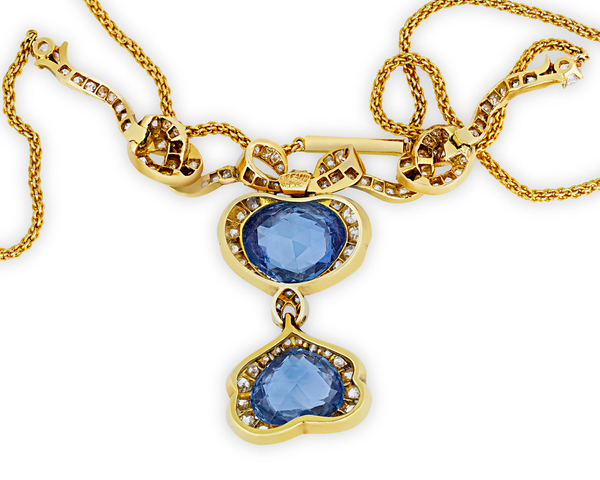Although silver is an enormously important part of Tiffany and Co.‘s history, one often thinks of jewelry when the name is mentioned. Much like Audrey Hepburn’s character in Breakfast at Tiffany’s, people across the world have long coveted the beautiful Tiffany box and the treasures they hold.
Firm History
The firm’s name was linked with astonishing diamonds and jewelry in 1878, when Tiffany acquired one of the world’s largest and most impressive fancy yellow diamonds from the Kimberley diamond mines in South Africa. Cut down from 287.42 carats to 128.54 carats with 82 facets under the expert eye of Tiffany’s head gemologist, Dr. George Frederick Kunz, this diamond was known worldwide for its fiery color and brilliance. It was named the Tiffany Diamond and set into a necklace worn by Audrey Hepburn in the publicity photographs for Breakfast at Tiffany’s in 1961. It was this diamond, with its canary-colored sparkle, that made the Tiffany & Co. name synonymous with the world’s most precious gemstones.

Louis Comfort Tiffany: Glassware Revolution
Louis Comfort Tiffany, son of Charles Lewis Tiffany, pursued his own artistic endeavors in lieu of taking on the family business with its focus on fine jewelry and silverware. Considered to be the driving force behind the Art Nouveau style in America, Tiffany worked with nearly every decorative medium imaginable, even serving as the first Design Director for his father's Tiffany & Co., but it is his personal triumphs in glassmaking that garnered the artist his highest recognition.
Though Tiffany first started his experiments with stained glass in 1875, it was not until 10 years later that he opened Tiffany Glass Company, which was later changed to Tiffany Studios in 1900. By that time, he was already the leading art glass producer in the country, serving wealthy New Yorkers and commissioning massive windows for Mark Twain, Cornelius Vanderbilt and even the White House. Due to Tiffany's ability to create incredible details in his windows using solely the qualities of his unique glass, a technique displayed in this striking Tiffany Figural Window, these masterpieces soon became known as "paintings in glass." In 1882, newly elected President Chester Alan Arthur refused to move into the White House until it had been redecorated. Tiffany worked on numerous rooms, infusing them with vibrant colors and patterns and, of course, adding Tiffany glass to many light fixtures and windows.
Jewelry
Tiffany's discovery of what he coined "favrile" glass (derived from and old English word meaning "handcrafted") in 1881 catapulted his reputation. Although he wanted to pursue large-scale favrile pieces, Tiffany understood the value of sticking to Tiffany's foundation of jewelry and smaller items. Tiffany’s move to focus on jewelry after his father’s death in 1902 was a natural progression from the jewel-like small objects he had been perfecting in prior years. Tiffany began producing enamelware—a technique in which vitreous paste is applied to metals using high heat—in 1898. Ever drawn to explore his own creativity and innovation, Tiffany was drawn to the exciting new color options enamels presented.
Unlike the extravagant jewelry produced under the direction of Charles Tiffany (1812–1902) at Tiffany & Co., Louis’ jewelry was distinguished by design and color. A review of the St. Louis world’s fair in The Craftsman (Vol. 7, November 1904) took note of Louis Comfort Tiffany’s jewelry and how he employed “unusual stones and gems; choosing them always solely with a view to the desired artistic result, and setting aside all question of their market value.”

These incredible sapphires would have been sourced by George Frederick Kunz, Tiffany & Co.'s expert gemologist, who selected only the finest gemstones for the firm's unique creations. The sapphires in this necklace are truly superior examples. Kashmir sapphires were first unearthed in the early 1880s after a landslide in the northwestern region of the Indian subcontinent. Tiffany both adored and cherished these gems not only for their rarity, but also for the softness of their distinctive blue hue.
Favrile Glass in Jewelry


The shimmering and iridescent qualities of Favrile glass proved to be the perfect medium for what Tiffany called his "beetle" jewelry. Based on the scarab, the Egyptian symbol of resurrection and immortality, favrile glass practically mirrored the insect's luminescence. Tiffany consistently used the scarab beetle as a motif throughout his oeuvre, and he used a mount similar to those of the Ancient Egyptians in order to protect the edges of the glass. Constructed in yellow gold, his pieces were often married enamel with semi-precious gemstones like moonstone, tourmaline and garnet. The present piece combines the best aspects of Tiffany’s diverse output, including his famed Favrile glass, a keen eye for design and the nature-inspired Art Nouveau aesthetics he perfected.
Modern Era

Since the firm's inception in 1837, Tiffany & Co. has been at the forefront of luxury design, especially in the realm of fine jewelry. This tradition continues to this day, and both antique and contemporary Tiffany jewelry remains highly coveted. Want to see more? Browse our impressive collection of Tiffany & Co. jewelry that is sure to leave you captivated.






